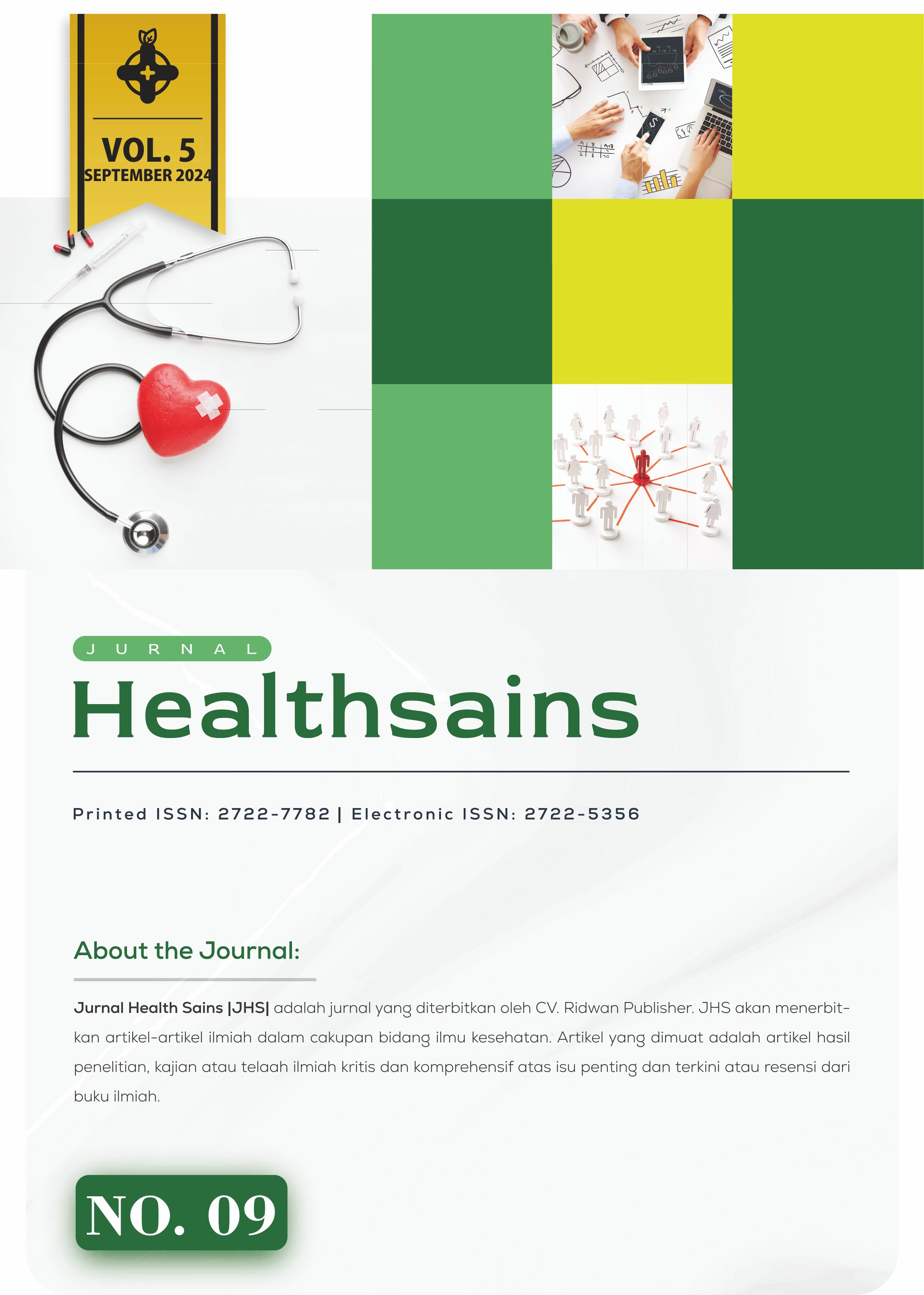The Effect of Topical 100% Sunflower Seed Oil (SSO) Extract on Trans Epidermal Water Loss (Tewl) and Skin PH Levels in a History of Atopic Dermatitis
DOI:
https://doi.org/10.46799/jhs.v5i9.1357Keywords:
sunflower seed oil, skin barrier therapy, TEWL, pHAbstract
The skin barrier function can be disturbed in various conditions, one of which is atopic dermatitis (AD). Efforts to improve the skin barrier can be done by using various types of moisturizers. Natural oil from sunflower seed oil (SSO) can be used as "skin barrier therapy" by reducing trans epidermal water loss (TEWL) and skin pH levels. A randomized single blind clinical trial with a two parallel group pre and post design was conducted on subjects with a history of AD who were treated at the Skin and Venereology Polyclinic at Sunan Kalijaga Hospital, Demak. Samples were randomized into 2 groups to receive 100% SSO or petrolatum as a control. TEWL and pH assessments were carried out at the beginning of the study and at week 4. Bathing habits and complaints about using moisturizers were also assessed. TEWL values decreased in the SSO and petrolatum groups (-5.8±1.93 vs -6.1±9.08, p = 0.9). The pH value in AD patients also decreased after administration of SSO extract and petrolatum (-0.4±0.10 vs -0.2±0.75, p = 0.2). The decrease in TEWL and pH in both groups was not statistically significant. This may be related to differences in bathing habits and moisturizer use in the two groups. Most of the samples in the SSO group stated that they had no complaints regarding usage. The entire sample completed the study without any reports of allergic reactions or hypersensitivity. Administration of SSO extract was effective in reducing TEWL and pH in DA with the majority of samples stating that they had no complaints about use.
References
Baumann, L. (2019). Cosmeceuticals and skin care in dermatology. Fitzpatrick’s in General Medicine.
Chan, C. X., & Zug, K. A. (2021). Diagnosis and management of dermatitis, including atopic, contact, and hand eczemas. Medical Clinics, 105(4), 611–626.
Cooke, A., Cork, M. J., Victor, S., Campbell, M., Danby, S., Chittock, J., & Lavender, T. (2016). Olive Oil, Sunflower Oil or no Oil for Baby Dry Skin or Massage: A Pilot, Assessor-blinded, Randomized Controlled Trial (the Oil in Baby SkincaRE [OBSeRvE] Study). Acta Dermato-Venereologica, 96(3).
Egawa, G., & Kabashima, K. (2018). Barrier dysfunction in the skin allergy. Allergology International, 67(1), 3–11.
Herrero-Fernandez, M., Montero-Vilchez, T., Diaz-Calvillo, P., Romera-Vilchez, M., Buendia-Eisman, A., & Arias-Santiago, S. (2022). Impact of water exposure and temperature changes on skin barrier function. Journal of Clinical Medicine, 11(2), 298.
Kang, S. (2019). Fitzpatrick’s dermatology. (No Title).
Kim, B. E., & Leung, D. Y. M. (2018). Significance of skin barrier dysfunction in atopic dermatitis. Allergy, Asthma & Immunology Research, 10(3), 207–215.
Langan, S. M., Abuabara, K., Henrickson, S. E., Hoffstad, O., & Margolis, D. J. (2017). Increased risk of cutaneous and systemic infections in atopic dermatitis—a cohort study. The Journal of Investigative Dermatology, 137(6), 1375.
Lin, T.-K., Zhong, L., & Santiago, J. L. (2017). Anti-inflammatory and skin barrier repair effects of topical application of some plant oils. International Journal of Molecular Sciences, 19(1), 70.
Lobefaro, F., Gualdi, G., Di Nuzzo, S., & Amerio, P. (2022). Atopic dermatitis: clinical aspects and unmet needs. Biomedicines, 10(11), 2927.
Pratama, R. N. (2017). Kinerja badan usaha milik desa panggung lestari dalam meningkatkan pendapatan asli desa di desa panggungharjo kecamatan sewon kabupaten bantul. Journal of Public Policy and Administration Research, 2(2), 105–116.
Pratami, R. R. E., Budiastuti, A., Riyanto, P., Malik, D. A., & Widayati, R. I. (2022). Sunflower seed oil for skin barrier repair in newborns: A systematic review and meta-analysis with biophysical parameters. Journal of Pakistan Association of Dermatologists, 32(1), 85–95.
Rubel, D., Thirumoorthy, T., Soebaryo, R. W., Weng, S. C. K., Gabriel, T. M., Villafuerte, L. L., Chu, C., Dhar, S., Parikh, D., & Wong, L. (2013). Consensus guidelines for the management of atopic dermatitis: An A sia–P acific perspective. The Journal of Dermatology, 40(3), 160–171.
Vaughn, A. R., Clark, A. K., Sivamani, R. K., & Shi, V. Y. (2018). Natural oils for skin-barrier repair: Ancient compounds now backed by modern science. American Journal of Clinical Dermatology, 19(1), 103–117.
Yang, G., Seok, J. K., Kang, H. C., Cho, Y.-Y., Lee, H. S., & Lee, J. Y. (2020). Skin barrier abnormalities and immune dysfunction in atopic dermatitis. International Journal of Molecular Sciences, 21(8), 2867.
Yu, J. J., Manus, M. B., Mueller, O., Windsor, S. C., Horvath, J. E., & Nunn, C. L. (2018). Antibacterial soap use impacts skin microbial communities in rural Madagascar. PloS One, 13(8), e0199899.
Published
Issue
Section
License
Copyright (c) 2024 Yunitasari Megawati, Retno Indar Widayati, Diah Adriani Malik

This work is licensed under a Creative Commons Attribution-ShareAlike 4.0 International License.
Authors who publish with this journal agree to the following terms:
- Authors retain copyright and grant the journal right of first publication with the work simultaneously licensed under aCreative Commons Attribution-ShareAlike 4.0 International (CC-BY-SA). that allows others to share the work with an acknowledgement of the work's authorship and initial publication in this journal.
- Authors are able to enter into separate, additional contractual arrangements for the non-exclusive distribution of the journal's published version of the work (e.g., post it to an institutional repository or publish it in a book), with an acknowledgement of its initial publication in this journal.
- Authors are permitted and encouraged to post their work online (e.g., in institutional repositories or on their website) prior to and during the submission process, as it can lead to productive exchanges, as well as earlier and greater citation of published work.






